
Reinhold Hilbers is a German businessman and politician of the Christian Democratic Union (CDU) who has been a member of the State Parliament of Lower Saxony since March 2003. From 2017 to 2022, served as State Minister of Finance in the government of Minister-President Stephan Weil.

Cloppenburg – Vechta is an electoral constituency represented in the Bundestag. It elects one member via first-past-the-post voting. Under the current constituency numbering system, it is designated as constituency 32. It is located in northwestern Lower Saxony, comprising the Cloppenburg and Vechta districts.
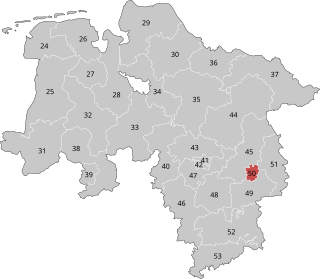
Braunschweig is an electoral constituency represented in the Bundestag. It elects one member via first-past-the-post voting. Under the current constituency numbering system, it is designated as constituency 50. It is located in southeastern Lower Saxony, comprising the city of Braunschweig.

Nienburg II – Schaumburg is an electoral constituency represented in the Bundestag. It elects one member via first-past-the-post voting. Under the current constituency numbering system, it is designated as constituency 40. It is located in central Lower Saxony, comprising the district of Schaumburg and most of the district of Nienburg.
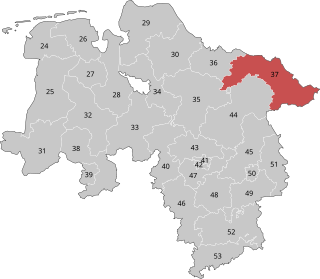
Lüchow-Dannenberg – Lüneburg is an electoral constituency represented in the Bundestag. It elects one member via first-past-the-post voting. Under the current constituency numbering system, it is designated as constituency 37. It is located in northeastern Lower Saxony, comprising the Lüchow-Dannenberg and Lüneburg districts.
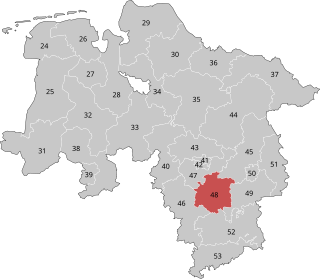
Hildesheim is an electoral constituency represented in the Bundestag. It elects one member via first-past-the-post voting. Under the current constituency numbering system, it is designated as constituency 48. It is located in southern Lower Saxony, comprising the district of Hildesheim.
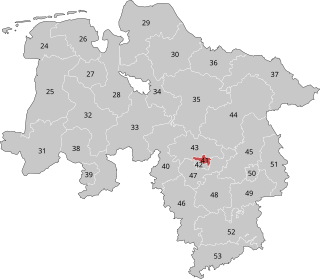
Stadt Hannover I is an electoral constituency represented in the Bundestag. It elects one member via first-past-the-post voting. Under the current constituency numbering system, it is designated as constituency 41. It is located in central Lower Saxony, comprising the northern part of the city of Hanover.
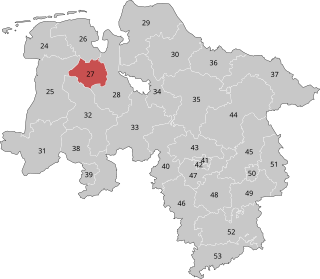
Oldenburg – Ammerland is an electoral constituency represented in the Bundestag. It elects one member via first-past-the-post voting. Under the current constituency numbering system, it is designated as constituency 27. It is located in northwestern Lower Saxony, comprising the city of Oldenburg and the district of Ammerland.

Salzgitter – Wolfenbüttel is an electoral constituency represented in the Bundestag. It elects one member via first-past-the-post voting. Under the current constituency numbering system, it is designated as constituency 49. It is located in southeastern Lower Saxony, comprising the city of Salzgitter, the district of Wolfenbüttel, and northern parts of the district of Goslar.

Rotenburg I – Heidekreis is an electoral constituency represented in the Bundestag. It elects one member via first-past-the-post voting. Under the current constituency numbering system, it is designated as constituency 35. It is located in northern Lower Saxony, comprising the Heidekreis district and the southern part of the Rotenburg district.

Celle – Uelzen is an electoral constituency represented in the Bundestag. It elects one member via first-past-the-post voting. Under the current constituency numbering system, it is designated as constituency 44. It is located in eastern Lower Saxony, comprising the districts of Celle and Uelzen.
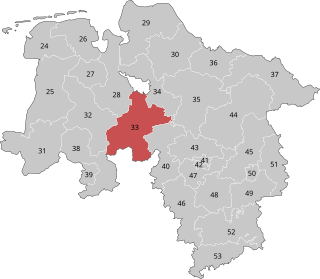
Diepholz – Nienburg I is an electoral constituency represented in the Bundestag. It elects one member via first-past-the-post voting. Under the current constituency numbering system, it is designated as constituency 33. It is located in central Lower Saxony, comprising the Diepholz district and parts of the Nienburg district.

Gifhorn – Peine is an electoral constituency represented in the Bundestag. It elects one member via first-past-the-post voting. Under the current constituency numbering system, it is designated as constituency 45. It is located in eastern Lower Saxony, comprising the Peine district and most of the Gifhorn district.

Göttingen is an electoral constituency represented in the Bundestag. It elects one member via first-past-the-post voting. Under the current constituency numbering system, it is designated as constituency 53. It is located in southern Lower Saxony, comprising most of the Göttingen district.
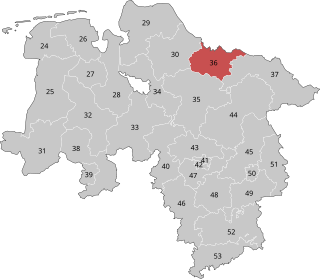
Harburg is an electoral constituency represented in the Bundestag. It elects one member via first-past-the-post voting. Under the current constituency numbering system, it is designated as constituency 36. It is located in northern Lower Saxony, comprising the district of Harburg.

Helmstedt – Wolfsburg is an electoral constituency represented in the Bundestag. It elects one member via first-past-the-post voting. Under the current constituency numbering system, it is designated as constituency 51. It is located in southeastern Lower Saxony, comprising the city of Wolfsburg, the district of Helmstedt, and part of the district of Gifhorn.

Osnabrück-Land is an electoral constituency represented in the Bundestag. It elects one member via first-past-the-post voting. Under the current constituency numbering system, it is designated as constituency 38. It is located in western Lower Saxony, comprising most of the district of Osnabrück.
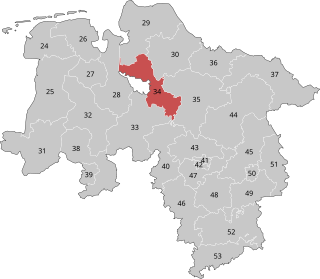
Osterholz – Verden is an electoral constituency represented in the Bundestag. It elects one member via first-past-the-post voting. Under the current constituency numbering system, it is designated as constituency 34. It is located in northern Lower Saxony, comprising the districts of Osterholz and Verden.
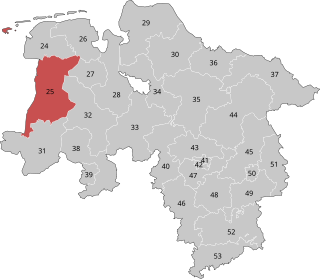
Unterems is an electoral constituency represented in the Bundestag. It elects one member via first-past-the-post voting. Under the current constituency numbering system, it is designated as constituency 25. It is located in northwestern Lower Saxony, comprising the district of Leer and the northern part of the district of Emsland.

Harz is an electoral constituency represented in the Bundestag. It elects one member via first-past-the-post voting. Under the current constituency numbering system, it is designated as constituency 68. It is located in western Saxony-Anhalt, comprising the district of Harz.




















